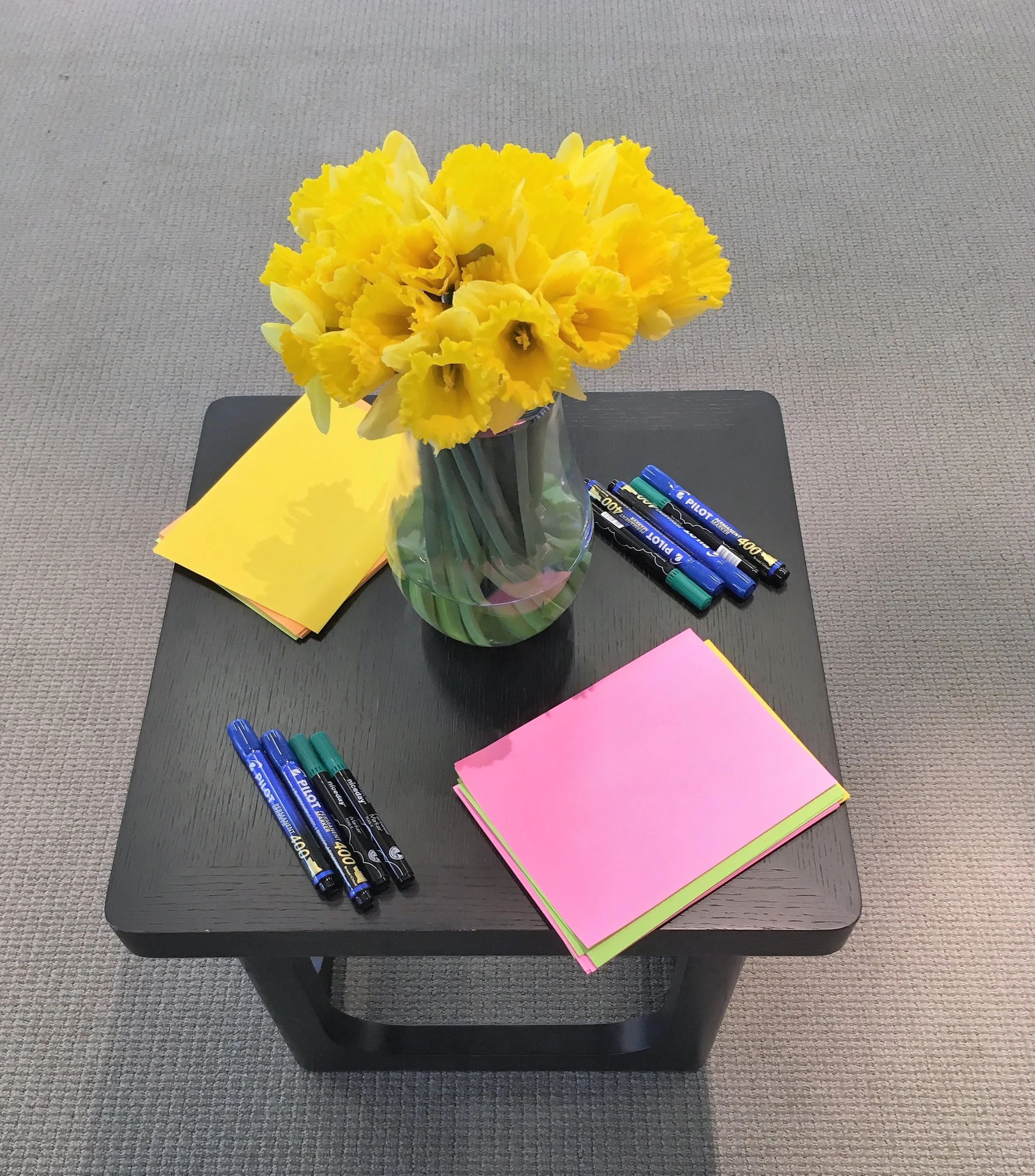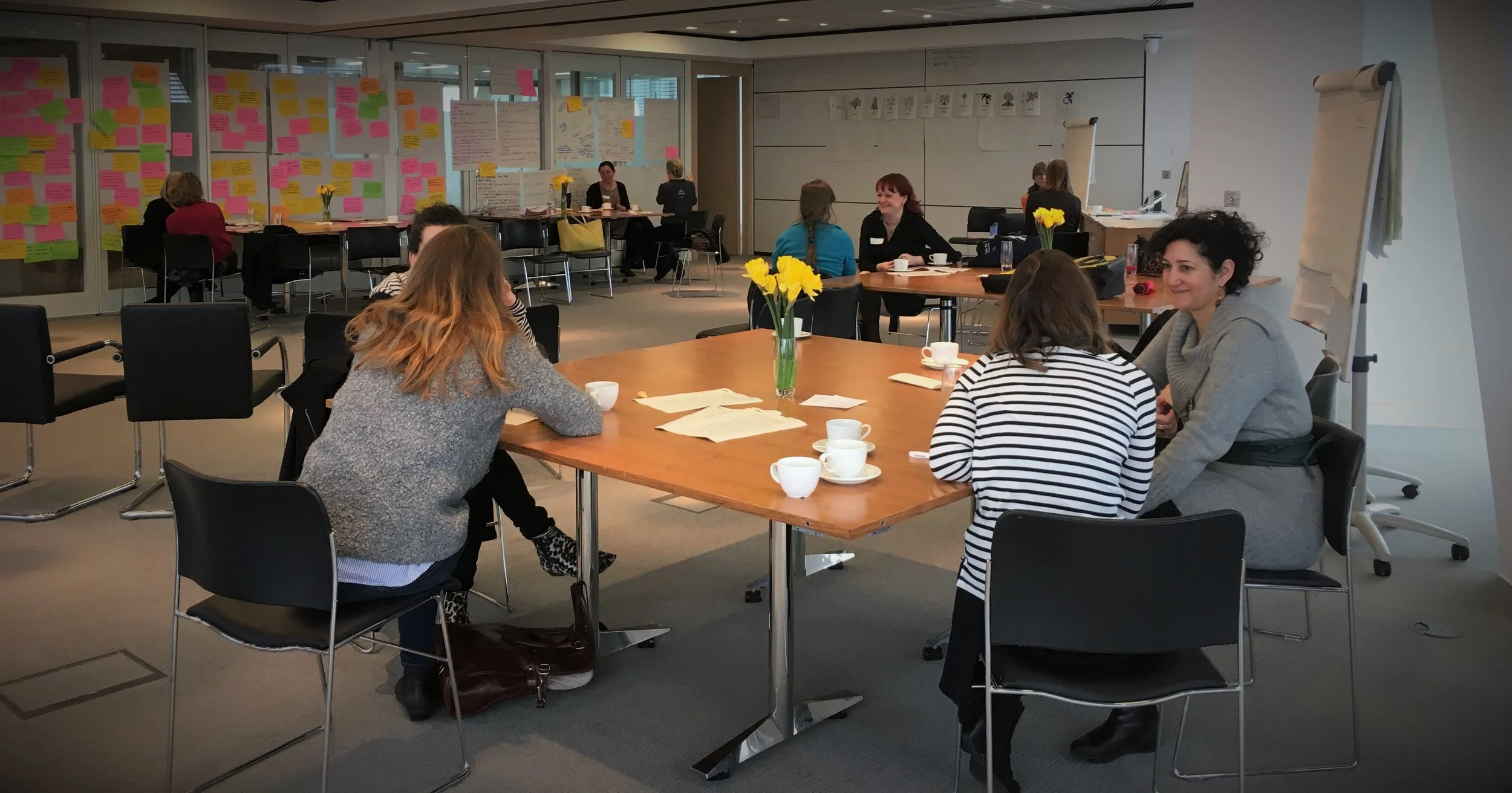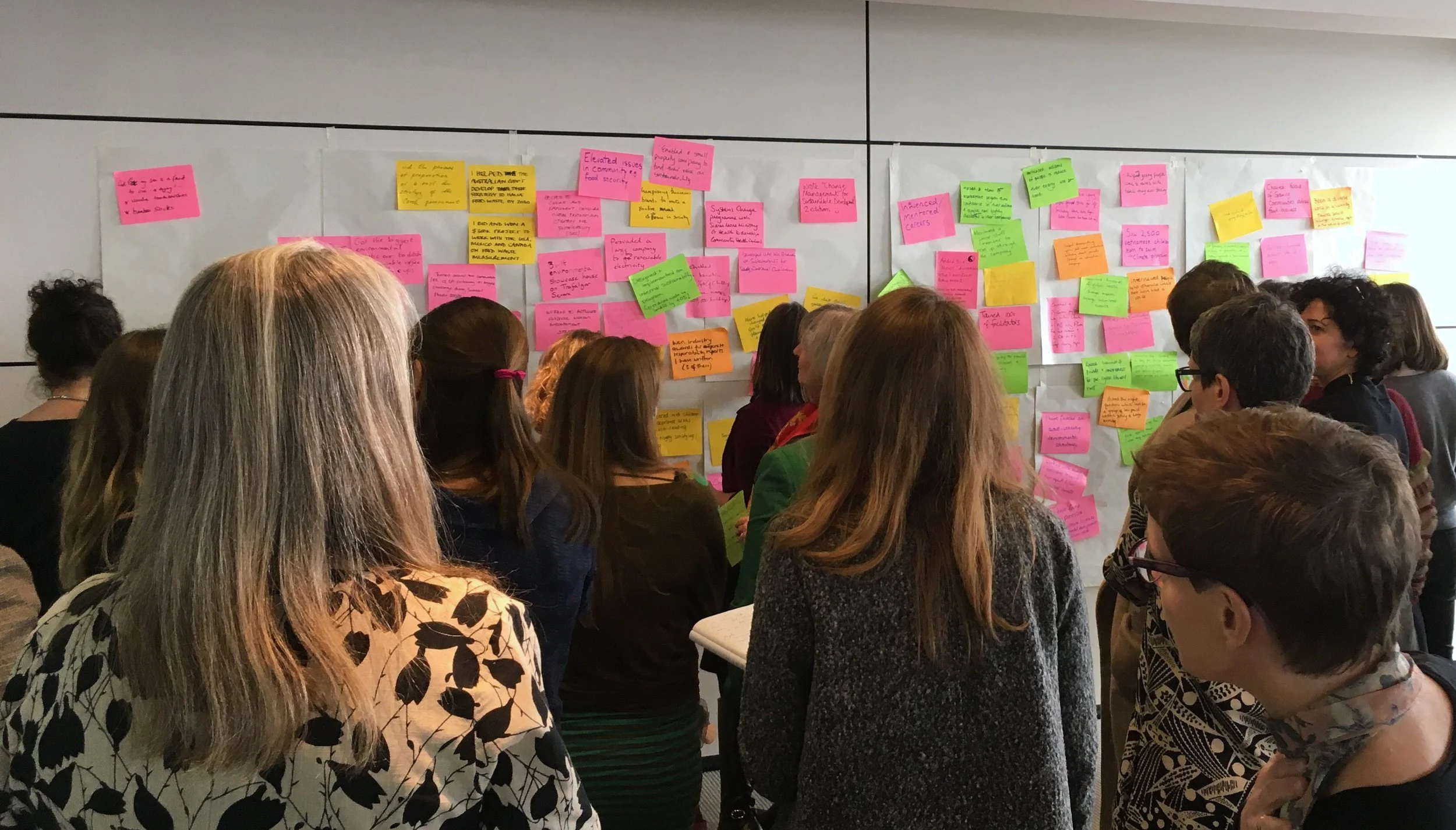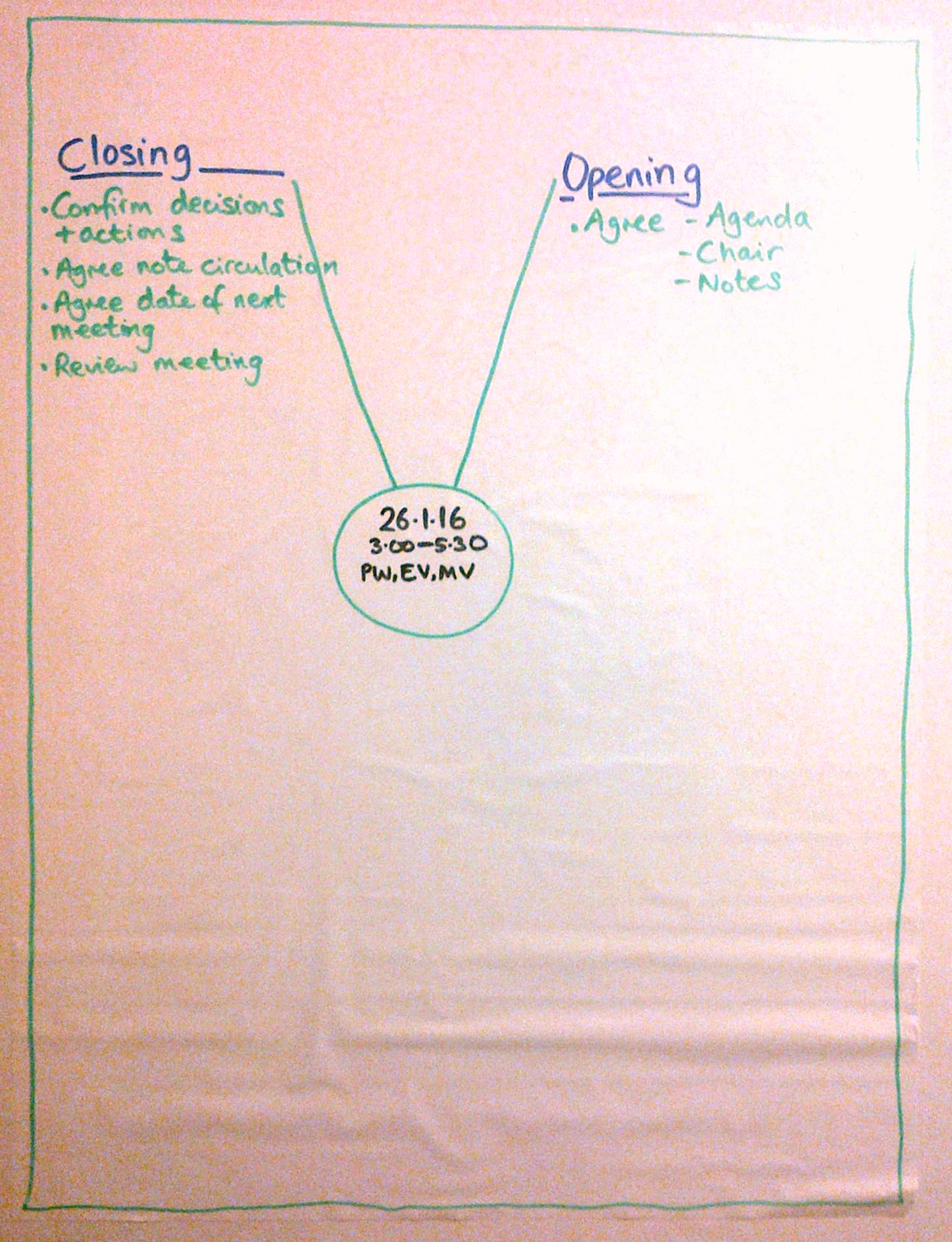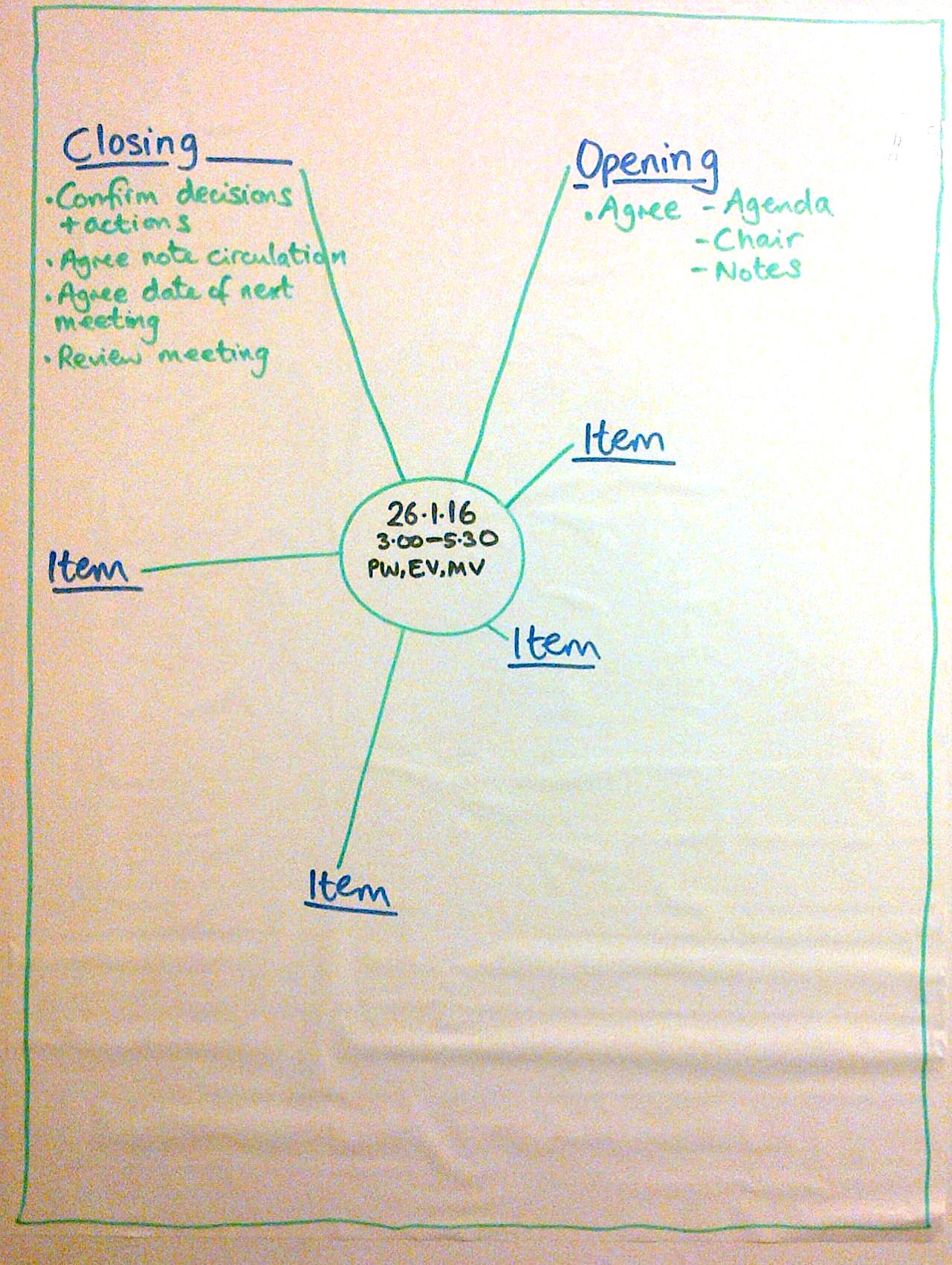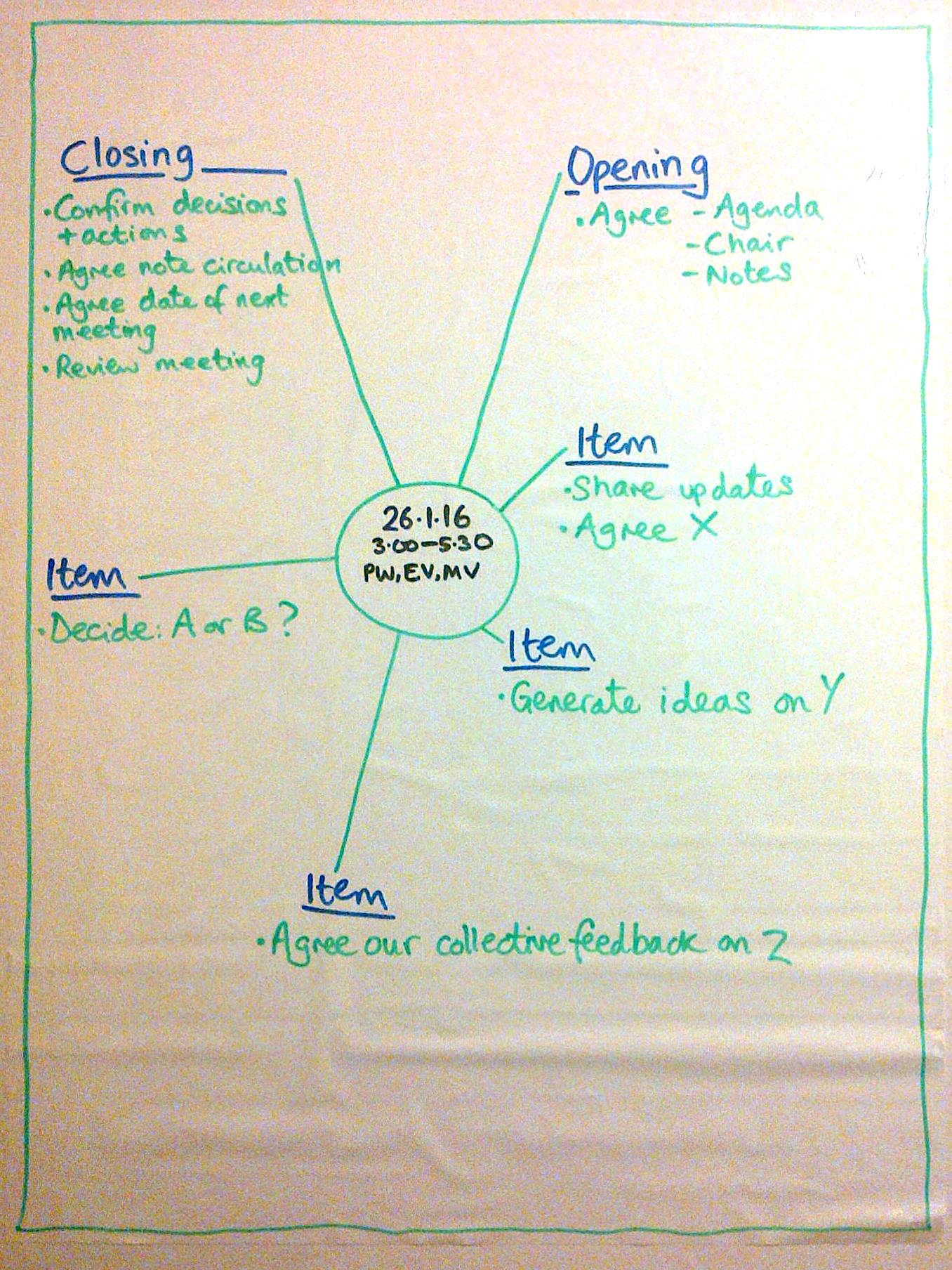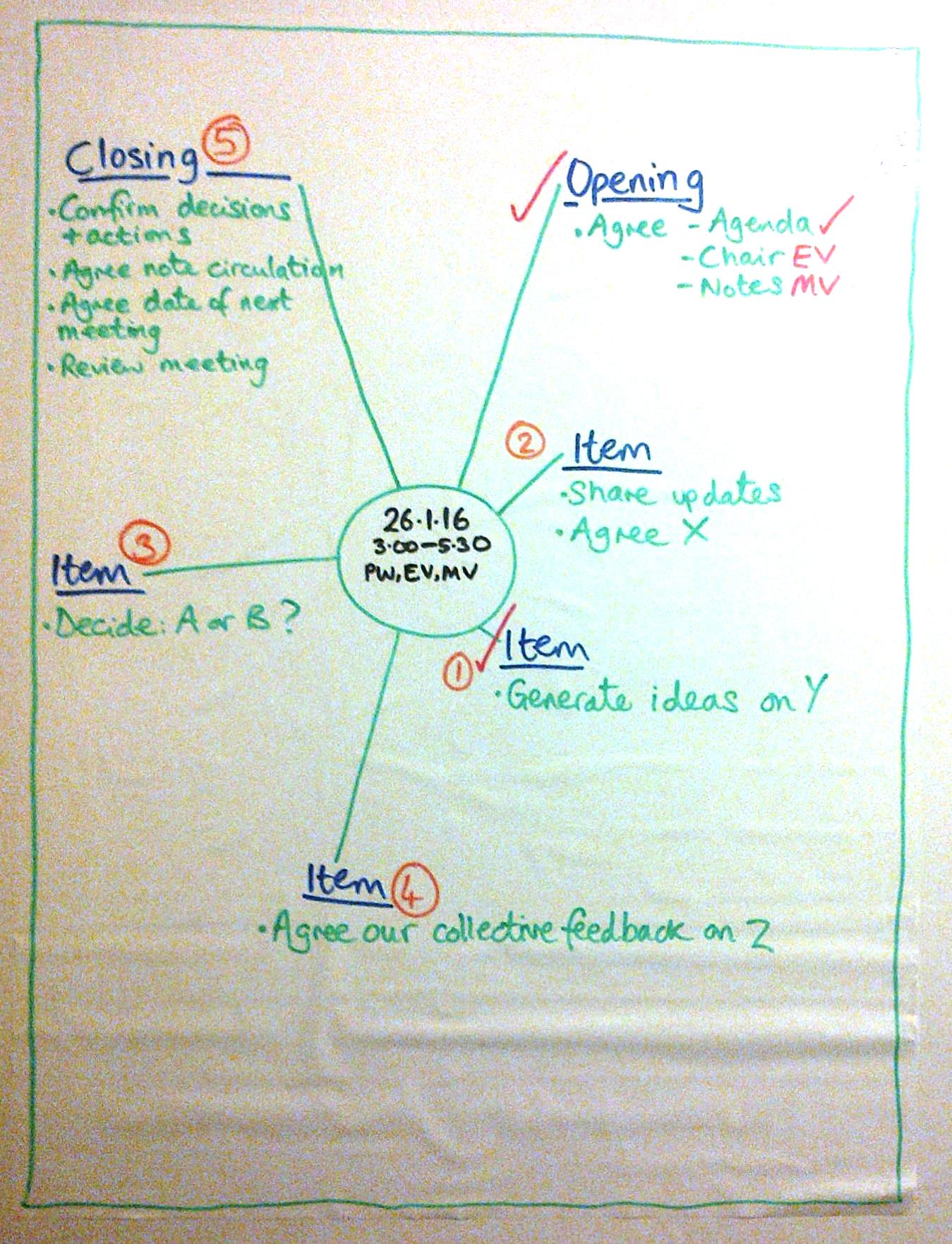Some people just hate shouting out ideas in a group. If you need quantity and creativity, and to make sure the quiet thinkers contribute their ideas too, this alternative to the traditional brainstorm is my new go-to technique.
Organising small groups within a larger event
There's a place for us... Choosing a venue
'Greening' our practice as facilitators
The two worlds I straddle - sustainability and process - interweave in all sorts of ways. And one of those ways involves challenging myself, and other facilitators, about the sustainability of our own practice. And although I've called this blog post 'greening' our practice, of course there are the social and ethical aspects of sustainability as well as the environmental ones to consider.
Paying attention to the mood
When I first met with Brigid Finlayson and Carolina Karlstrom, to see whether we could work together to create the first She is Still Sustainable, we talked a lot about the kind of event we wanted to make it. And our conversation focused a lot on mood, atmosphere, emotional tone: we wanted it to be “warm, safe, friendly event which is refreshing, inspiring and supportive”.
Doing the work in sustainability that we want to do
Lots of the women who came along to She is Still Sustainable said that the highlight was a co-coaching exercise we ran, using a solutions focus approach. People paired up and coached each other, asking positive, future-oriented questions about the sustainability work they wanted to do. The instructions are here.
On the spot, in the room
Any fool can design a workshop. What really tests you is having to redesign it part-way through.
You’ve done a great plan, and prepared your materials. You know how you’d like the space laid out, and your workshop will take the group on a journey towards a convergent, satisfying conclusion.
And then it all goes horribly wrong. Nasty surprises throw your plans into disarray. You need to redesign and you need to do it NOW!
Celebrate your achievements!
One of the lovely things that we did at She is Still Sustainable last month, was to build a wonderwall of our achievements. And wow! What a lot we have achieved.
Some were very personal – surviving divorce, arranging funerals, raising children....
Some had enormous reach – training 100s of facilitators, systems change programme with Sierra Leone Ministry of Health to improve community health, part of a team delivering a sustainable London 2012...
Personal resilience - three ways to build yours
One of the things that came up again and again when I was talking to people about the new edition of Change Management for Sustainable Development, was supporting ourselves as sustainability professionals and as change-makers. There are three key pillars which support us: perspective, association, and giving ourselves a break.
Where next for your sustainability strategy?
In these turbulent days, with right-wing populist movements rising and an unpredictable political context, you may be asking yourself how this should be reflected in your sustainability strategy.
Perhaps there are critical business and organisational issues which need addressing, regardless of political uncertainty.
Carousel in action
What do we need now, from sustainability leaders?
When I got the news about the US Presidential election result, I went through a lot emotions that I'm still processing.
One that may have been shared by those of you who are looked to for leadership - in ways big or small - was uncertainty about what to say to people who are wanting guidance. I had to think about this pretty quickly, as I'd been asked present on leadership in the closing session of a four-day workshop on sustainable business.
Campaigners, community groups, activists and faith groups - run your business meetings better so you can get on with the important stuff!
If you're involved in a local group - campaigners, activists, community action, faith group - there will be some really important things you want to achieve in the world. And you'll have some kind of team, committee, council or similar organising the activities behind the scenes. How are those meetings? Clear, engaging, effective? Or dull, interminable, frustrating, repetitive?
I've led a couple of two-hour training sessions this year for groups on how to run meetings which make clear decisions that stick. So that they can spend time on doing the stuff that really matters.
Here are the handouts from the workshop I ran in mid November.
If you think your group would benefit, get in touch to see what I can do to help you.
Peer learning workshops - some emerging ideas
I'm excited about ideas for peer learning workshops that have been bubbling away in my head and are beginning to take shape.
Focused, coachy, peer learning
I want to bring together sustainability people of various kinds, to be able to talk with each other about their challenges and ideas in a more expansive and easeful way than a conference allows.
People really benefit from being able to think aloud in coaching conversations. I've seen the transformations that can happen when supportive challenge prompts a new way of looking at things.
We also get so much from comparing our own experiences with peers: finding the common threads in individual contexts, exploring ideas about ways forward.
I’d like to combine these things by making the peer learning available in smaller groups and smaller chunks, where the atmosphere is more like coaching.
What's the idea?
The idea is to run half-day workshops, with between 6 and 10 people at each event. The intention is that they are safe and supporting spaces, where people can talk freely. We'll meet in spaces that are relaxed, creative, private, energising and feel good to be in. (More comfortable than the stone steps in the picture.)
Each workshop would have a theme, to help focus the conversations and make sure people who come along have enough in common for those conversations to be highly productive.
I'd run a few, on different themes, and people can come to one, some or all of them. They don't have to come to them all, so the mix of people will be different for each workshop.
I'd charge fees, probably tiered pricing so that it's affordable for individuals and smaller not-for-profits, but commercial prices for bigger and for-profit organisations.
The content of each workshop will come from the participants, rather than me: my role is to facilitate the conversations, rather than to teach or train people.
Choices, dilemmas, testing
When I've tested this idea with a few people, many have said that the success of the workshops will depend on who else is there: people with experience, insight, credibility. People they feel able to trust, before they commit to booking. I think this is useful feedback.
On the other hand, I'm unsure about the best way to ensure this. Is it enough to include a description of "who these workshops are for" and leave it to people to decide for themselves? Or should I set up an application process of some kind: asking people who apply to include a short explanation of who they are, what their role and experience is, and why they want to come along.
If I set up an 'application' process, will that be off-putting to the naturally modest? Too cumbersome? Adding extra steps (apply, wait, get place confirmed, then pay...) feels risky: at each step, the pool of likely participants will get smaller. Will this make the workshops unviable? Who am I to choose, anyway?
Another option is to make the workshops 'by invitation' with people having the option of requesting an invitation for their friends, peers, colleagues - or even themselves. This is what I'm leaning towards at the moment, based on gut feel.
Will this increase people's confidence in the workshops - that not just anyone gets a place, their peers will provide quality reflections and be people worth meeting? Will it make those people who do get an invitation feel special, better about themselves?
And will I really turn down anyone who asks for an invitation? What will they feel?
I've set up a survey to gather views on this, as well as on the topics that will be most interesting to people. Please let me know here where's there a short survey. Discounts and prizes available!
How it feels to experiment
I'm not a natural entrepreneur. Some people love to experiment and learn from failure. Fail faster. Fail cheaper. Intellectually I'm committed to experimenting with these workshops: testing out ideas about formats, marketing, pricing, venues, topic focus vs emergence, length, the amount of 'taught' content vs 'created' content and so on.
Emotionally: not so much. I want to get everything right before I start (which is why it's taken me about six months to even get to this stage). I'm getting great support from lots of people, and boy do I need it. Even sitting here, I can feel the prickly, clammy, cold physical manifestations of the fear of failure.
I need to move through the fear and into the phase of actually running some test workshops. I know they'll be great. I can see the smiles, feel the warmth, visualise the kind of room we're meeting in and the I already have the design and process clear. I have a shelf of simple but beautiful props in my office. I am 100% confident about the events themselves, it's the communications and administration of the marketing that freaks me out.
Learning from the learning
So already I'm learning. About myself, about what people say they need, about how venues can be welcoming or off-putting, about how generous people are with their time and feedback.
She is Sustainable - sustaining the sustainers
Vertically, horizontally or circularly ambitious? Mothering or child-free, by choice or randomness? Urban or rural? Partnered for life or a free agent? Gay or straight or something else? Employed, entrepreneur or freelance?
Women who work in sustainability are all these things and more.
She is Sustainable was invented by five UK-based sustainability women (Becky Willis, Solitaire Townsend, Amy Mount, Hannah Hislop and Melissa Miners) who thought…
The morning after the night before - debriefing events
A lot of projects have been completed in the last couple of weeks, so I've been encouraging clients to have debriefing conversations.
Although I always include some kind of debrief in my costings, not all clients find the time to take up this opportunity. That's such a shame! We can learn something about how to bring people together to have better conversations, every time we do it.
Structuring the debrief
I've been using a simple three question structure:
- What went well?
- What went less well?
- What would you do differently, or more of, next time?
This works in face to face debriefing, telecons and can even form a useful way of prompting a debriefing conversation that takes place in writing: in some kind of joint cyberplace, or by email.
If we haven't already had a conversation about immediate next steps, then I'll add this fourth question:
- What do we need to do next?
Referring back to the aims
Since, for me, the aims are the starting point for the design process, they should also be the starting point for the debriefing conversation. To what extent did we meet our aims? What else might the client team need to do in next weeks and months, to get closer to meeting the aims?
Evidence to draw on
It's really helpful for the team to have access to whatever the participants have fed back about how the process or event worked for them. Sometimes we use paper feedback forms in the room, sometimes an electronic survey after the event. Quantitative and qualitative reports based on this feedback can help people compare their intuitive judgements against what participants have said.
In other situations, we make time in the process for participants to have their own conversation about how things have gone. A favourite technique is to post up a flip with an evaluation question like "to what extent did we meet our aims?". The scale is drawn on, and labelled "not at all" to "completely". Participants use dots to show their response to the question, and then we discuss the result. I often also post up flips headed "what helped?" and "what got in the way?". People can write their responses directly on to the flips. This is particularly useful when a group will be meeting together again, and can take more and more responsibility for reflecting on and improving its ways of working effectively.
What's been learnt?
Some of the unexpected things to have come out of recent debriefs:
- The things that actually get done may be more important than the stated aims: one workshop only partially met its explicit aims to develop consensus on topic X, but exceeded client expectations in building better working relationships, making it easier to talk later about topic Y.
- What people write in their questionnaire responses can be quite different to the things you heard from one or two louder voices on the day.
- A debriefing conversation can be a good way of briefing a new team member.
And the obvious can be reinforced too: clarity on aims really helps, thinking about preparation and giving people time to prepare really helps, allowing and enabling participation really helps, good food really helps!
Some lessons from Citizens Juries enquiring into onshore wind in Scotland
I've been reading "Involving communities in deliberation: A study of 3 citizens’ juries on onshore wind farms in Scotland" by Dr. Jennifer Roberts (University of Strathclyde) and Dr. Oliver Escobar (University of Edinburgh), published in May 2015.
This is a long, detailed report with lots of great facilitation and public participation geekery in it. I've picked out some things that stood out for me and that I'm able to contrast or build on from my own (limited) experience of facilitating a Citizens' Jury. But there are plenty more insights so do read it for yourself.
I've stuck to points about the Citizen Jury process - if you're looking for insights into onshore wind in Scotland, you won't find them in this blog post!
What are Citizens' Juries for?
This report takes as an underlying assumption that its focus - and a key purpose of deliberation - is learning and opinion change, which will then influence the policies and decisions of others. The jury is not seen as "an actual decision making process" p 19
"Then ... the organisers feed the outputs into the relevant policy and/or decision making processes." p4
In the test of a Citizens’ Jury that I helped run for NHS Citizen, there was quite a different mandate being piloted. The idea is that when the Citizens’ Jury is run ‘for real’ in NHS Citizen, it will decide the agenda items for a forthcoming Board Meeting of NHS England.
This is a critical distinction, and anyone commissioning a Citizens’ Jury needs to be very clear what the Jury is empowered to decide (if anything) and what it is being asked for its views, opinions or preferences on. In the latter case, the Citizens’ Jury becomes essentially a sophisticated form of consultation.
This is not necessarily a bad thing, but it needs to be very clear from the start which type of involvement is being sought.
Having confidence in the Citizens’ Jury process
To be a useful consultant mechanism, stakeholders and decision-makers need to have confidence in the Citizens’ Jury process. This applies even more strongly when the Jury has decision-making powers.
The organisers and commissioners need to consider how to ensure confidence in a range of things:
- the selection of jurors and witnesses,
- the design of the process (including the questions jurors are invited to consider and the scope of the conversations),
- the facilitation of conversations,
- the record made of conversations and in particular decisions or recommendation,
The juries under consideration in this report benefited from a Stewarding Board. This type of group is sometimes called a steering group or oversight group. It’s job is to ensure the actual and perceived independence of the process, by ensuring that it is acceptable to parties with quite difference agendas and perspectives. If they can agree that it’s fair, then it probably is. Chapter 3 of the report looks at this importance of the Stewarding Board, its composition and the challenging disagreements it needed to resolve in this process.
In our NHS Citizen test of the Citizens’ Jury concept, we didn’t have an equivalent structure, although we did seek advice and feedback from the wider NHS Citizen community (for example see this blog post and the comment thread) as well as from our witnesses, evaluators with experience of Citizens’ Juries. We also drew on our own insights and judgements as independent convenors and facilitators. My recommendation is that there be a steering group of some kind for future Citizens’ Juries within NHS Citizen.
What role for campaigners and activists?
The report contains some interesting reflections on the relationship between deliberative conversations in ‘mini publics’ and citizens who have chosen to become better informed and more active on an issue to the extent of becoming activists or campaigners. (Mini public is an umbrella term for any kind of “forum composed of citizens who have been randomly selected to reflect the range of demographic and attitudinal characteristics from the broader population – e.g. age, gender, income, opinion, etc.” pp3-4)
The report talks about a key feature of Citizens’ Juries being that they
“...use random selection to ensure diversity and thus “reduce the influence of elites, interest advocates and the ‘incensed and articulate’”
(The embedded quote is from Carolyn Hendriks’ 2011. The politics of public deliberation: citizen engagement and interest advocacy, Basingstoke, Palgrave Macmillan.)
So what is the role of the incensed and the articulate in a Citizens’ Jury? The detail of this would be decided by the steering group or equivalent, but broadly there are two roles outlined in the report: being a member of the steering group and thus helping to ensure confidence in the process; and being a witness, helping the jurors to see multiple aspects of the problem they are considering. See pp 239-240 for more on this.
Depending on the scope of the questions the Citizens’ Jury is being asked to deliberate, this could mean a very large steering group or set of witnesses. The latter would increase the length of the jury process considerably, which makes scoping the questions a pragmatic as well as a principled decision.
The project ran from April 2013 to May 2015. You can read the full report here.
Thanks very much to Clive Mitchell of Involve who tipped me off about this report.
See also my reflections on the use of webcasting for the NHS Citizen Citizens' Jury test.
What kind of workshop? Some metaphors
I've been working with a small client team to design a workshop. The client team see lots of weaknesses in the current set-up that the group is a part of. As the fighter pilot said when surrounded by enemy planes, it is a target-rich environment. So where do we begin?
We discussed jumping in and asking the biggest, baddest questions about the group's role and existence. We played around with focusing on process tasks like revisiting terms of reference. We thought about starting with easy wins.
The someone suggested a garden metaphor: the group and its work is a garden and - so he thought - the implication is that we want to do something evolutionary not revolutionary.
Maybe.
It got me thinking about the different kinds of interventions you might make in a garden - which could be radical as well as incremental - and we used these metaphors to help us reach a clearer common view about what the workshop should be like.
Dreaming of warm sunny evenings
Especially at this time of year, when nothing much is growing and the days are moist and cold, many gardeners will be dreaming of long summer evenings with a glass of wine and artfully placed candles. Scents and seating and shade. We could use the workshop to dream about the desired future, building a rich shared vision that inspires us during the hard months ahead.
Rip it up and start again
Not all interventions in gardens are evolutionary. People sometimes decide to completely remodel their garden: hard landscaping, tree removal, new soil, the works. So a workshop could work on new plans: where to put the pond, as it were. And people could even move on to project planning: when to get the diggers in.
Weeding party
Or the workshop could be like a work party: lots of practical immediate stuff to get on with: weed the borders, turn the compost heap, sew the broad beans and repair the fence.
Using metaphors helped us decide
Tossing these options around helped us decide on the kind of workshop we wanted, before we agreed on the detailed draft aims. We went for the weeding party. Trowels at the ready!
What metaphors have helped you, in designing and planning workshops?
Location, location, location
Picture the scene: the room, which you haven't been able to check out before, has a low ceiling, tiny windows that somehow don't manage to let in much light, and is decorated in shades of brown and purple. There are uplighters on the walls, which have large strategically placed paintings screwed to them. And, of course, you have been told that under no circumstances can blu-tack be used on the rough-textured wallpaper.
What your facilitator will ask!
So you've decided that the meeting or workshop you have in mind needs an independent, professional facilitator. You call them up and guess what? They start asking all these awkward questions. What's that about?
Facilitators don't just turn up and facilitate
Facilitated meetings are increasingly popular, and many teams and project groups understand the benefits of having their workshop facilitated. More and more organisations are also wanting to have meaningful, productive conversations with stakeholders, perhaps even deciding things together and collaborating. Facilitated workshops can be a great way of moving this kind of thing forward. But facilitators don't just turn up and facilitate. So what are the key things a facilitator will want to know, when they're trying to understand the system, before the big day itself?
Start with the ends
Your facilitator will always begin with the purpose or objectives - why is the meeting being held? What do you want to be different, after the meeting? This could be a difference in the information that people have (content), new agreements or decisions (process), or it could be that what is needed is a shift in the way people see each other (relationships) - or some of each of these things.
Context and history
Once the facilitator is confident that you are clear about the purpose (and this could take some time - the facilitator should persist!), then the facilitator will want to understand the context, and the people.
Context includes the internal context - what has you organisation done up to now, what other processes or history have led up to this workshop? It also includes the external context - what in the outside world is going to have an impact on the people in the room and the topic they are working on?
Who's coming?
Often, the one thing that has been fixed before the facilitator gets a look in is the people who have been invited. But are they the right people to achieve the objectives? Have some important oilers or spoilers, information holders or information needers been left out? And do they understand clearly what the objectives of the meeting are?
Getting the right people in the room (and making arrangements to involve people who need to take part, but can't actually be there on the day) is just part of it. What do the people need to know, in order to play an effective part in the meeting? And how far ahead does this information need to be circulated? Apart from passively receiving information, what information, views or suggestions can be gathered from participants before the meeting, to get people thinking in advance and save time for interaction and creative discussion on the day? What questions can be gathered (and answered) in advance?
What do the participants want out of the meeting? If this is very different to what the client or sponsor wants, then this gap of expectations needs to be positively managed.
When and where?
Apart from the invitation list, the other things which are usually fixed before the facilitator is brought in, and which they may challenge, with justification, are the date and the venue.
The date needs to be far enough away to ensure that participants get adequate notice, and the facilitator, client team and participants get adequate preparation time.
The venue needs to be suitable for the event - and for a facilitated meeting, traditional conference venues may not be. Inflexible room layout, a ban on blu-tack, rigid refreshment times - all of these make a venue hard to use, however handy it may be for the golf course. There's more on venues here.
Workshop design
Sometimes, of course, the date, venue and participant list are unchangeable, whatever the facilitator would like, and have to be taken as fixed points to be designed around. So what about the overall meeting design? The facilitator will want to understand any 'inputs' to the meeting, and where they have come from. They'll want to talk about the kind of atmosphere which will be most helpful, and about any fixed points in the agenda (like a speech by the Chief Exec), and how these can be used most positively.
A design for the meeting will be produced, and circulated to key people (the client, maybe a selection of participants), and amended in light of their comments. But the facilitator will always want to retain some flexibility, to respond to what happens 'in the room'.
What next?
And after the meeting? The 'after' should be well planned too - what kind of report or record is needed, and will there be different reports for different groups of people? This will have an impact on the way the meeting is recorded as it goes along - e.g. on flip chart paper, on display for all to see and for people to correct at the time. If there are specific 'products' from the meeting (agreements, action points, priorities, principles or statements of some kind, options or proposals), what is going to happen to them next?
And how will the client, facilitator and participants give and receive feedback about how the process worked?
All these things will need to be thought about early on - clients should expect their facilitators to ask about them all - and to help them work out the answers!
Challenging conversations
So to sum up, the facilitator will potentially challenge the client team about:
• Objectives • Context • Participants • Space • On-the-day process • Follow-up process
Free download
If you'd like to download a version of this, click here.




